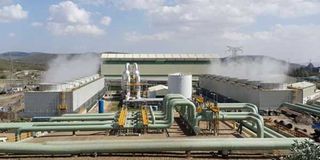A look into the heartbeat of economy

Geothermal power generation in Olkaria. Looking at the Ministry of Energy’s mission — to facilitate provision of clean, sustainable, affordable, reliable and secure energy services for national development while protecting the environment — we can say that the ministry is to the country what the heart is to the body. FILE PHOTO | NATION MEDIA GROUP
What you need to know:
The first step to clean and reliable energy is adequate generation.
When Kenya relied on hydro-power we learnt that we need to diversify energy generation.
In science, we learnt that energy is the capacity to work.
Looking at the Ministry of Energy’s mission — to facilitate provision of clean, sustainable, affordable, reliable and secure energy services for national development while protecting the environment — we can say that the ministry is to the country what the heart is to the body.
Just as the beating of the heart facilitates blood circulation, which enables all other functions in living organisms, the ministry plays a critical role in enabling the government’s ‘Big Four’ agenda, particularly the fulfilment of the manufacturing pillar.
The first step to clean and reliable energy is adequate generation.
HYDRO-POWER
When Kenya relied on hydro-power, which is prone to weather changes, we learnt that we need to diversify energy generation.
The Kenya Electricity Generating Company (KenGen) capacity has grown tremendously to 1,631 megawatts against the country’s average peak demand of about 1,770MW.
KenGen is set to commission the 166MW Olkaria V geothermal power plant by June while the Geothermal Development Company (GDC) expects to launch the 105MW power generation by three independent power producers (IPPs) next year.
Kenya Power and Lighting Company (KPLC), the sole electricity retailer, better known as Kenya Power, has signed up with several IPPs.
The ministry, through the Kenya Nuclear Electricity Board (KNEB), has a programme geared at providing a robust energy mix and complementing other sources of electricity.
NUCLEAR POWER
Kenya’s Nuclear Power Programme targets to have the first nuclear power plant in the country by 2027.
To improve the transfer of electricity to the users, the ministry, through Kenya Electricity Transmission Company Limited (Ketraco), has embarked on numerous projects to address the challenges.
They include addressing low voltages and transmission losses, injecting power into the national grid, enhancing economic integration and low access and connectivity.
Ketraco had energised various transmission lines and completed 36 sub-stations by last December. Ongoing projects include 4,000 kilometres of 132KV, 220KV and 400KV high-voltage lines.
That will result in a stable national grid that will address the challenge of unreliable power supply.
Ketraco delivers power to KPLC. Large power consumers (where many manufacturing companies fall) make about 1 per cent of Kenya Power’s customer base but buy over 60 per cent of energy in Kenya.
ALTERNATIVE LINES
It is, therefore, building alternative lines for these customers to eliminate electricity interruptions during operation and maintenance shutdowns. Also, the new Time of Use tariff is aimed at increasing night operations of manufacturers.
To enhance access to electricity in the underserved rural areas, Rural Electrification Authority (REA) targets to connect all public facilities by 2020.
Aiming at supporting growth of small-scale manufacturing plants and agro industries in rural areas, these will include milk cooling plants, tea buying centres and market centres across the country.
JOB CREATION
REA is also electrifying public water facilities, especially in arid and semi-arid areas, using solar power to help the communities to not only get drinking water but also undertake irrigation and other value-addition activities such as milk preservation, yoghurt production, food processing and milling.
Apart from enabling job creation, the ministry and its agencies provide indirect employment through the government policy of giving a minimum of 30 per cent of its procurement opportunities to youth, women and persons with disabilities.
BUY KENYA, BUILD KENYA
Another policy aimed at creating employment indirectly in the sector is implementation of the Buy Kenya, Build Kenya initiative, where the ministry and its agencies award 40 per cent of tenders for supply of goods and services to local manufacturers and citizen contractors.
The energy sector is regulated by the Energy Regulatory Commission (ERC), which is responsible for technical and economic regulation of the sector. ERC has a key mandate to ensure provision of sustainable energy, including provision of high-quality energy and competitive tariffs to spur the manufacturing sector.
The ministry and its agencies are firmly seized of their mandate to power the economy and, hence, contribute immensely to the success of the ‘Big Four’. The heart of the economy must continue beating!
Dr Njoroge, an engineer, is Principal Secretary in the Ministry of Energy. [email protected]




